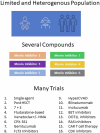Menin inhibitors in pediatric acute leukemia: a comprehensive review and recommendations to accelerate progress in collaboration with adult leukemia and the international community
- PMID: 39179671
- PMCID: PMC11436367
- DOI: 10.1038/s41375-024-02368-7
Menin inhibitors in pediatric acute leukemia: a comprehensive review and recommendations to accelerate progress in collaboration with adult leukemia and the international community
Abstract
Aberrant expression of HOX and MEIS1 family genes, as seen in KMT2A-rearranged, NUP98-rearranged, or NPM1-mutated leukemias leads to arrested differentiation and leukemia development. HOX family genes are essential gatekeepers of physiologic hematopoiesis, and their expression is regulated by the interaction between KMT2A and menin. Menin inhibitors block this interaction, downregulate the abnormal expression of MEIS1 and other transcription factors and thereby release the differentiation block. Menin inhibitors show significant clinical efficacy against KMT2A-rearranged and NPM1-mutated acute leukemias, with promising potential to address unmet needs in various pediatric leukemia subtypes. In this collaborative initiative, pediatric and adult hematologists/oncologists, and stem cell transplant physicians have united their expertise to explore the potential of menin inhibitors in pediatric leukemia treatment internationally. Our efforts aim to provide a comprehensive clinical overview of menin inhibitors, integrating preclinical evidence and insights from ongoing global clinical trials. Additionally, we propose future international, inclusive, and efficient clinical trial designs, integrating pediatric populations in adult trials, to ensure broad access to this promising therapy for all children and adolescents with menin-dependent leukemias.
© 2024. This is a U.S. Government work and not under copyright protection in the US; foreign copyright protection may apply.
Conflict of interest statement
C. Michel Zwaan: Receives research funding from AbbVie, BMS, Gilead, Kura Oncology, Novartis, Pfizer, Syndax, and Takeda. Engages in consultancy for BMS, Gilead, and Novartis. - Ghayas Issa: Receives consultancy and research funding from Astex, Celgene, Kura Oncology, Merck, Novartis, NuProbe, and Syndax. - BC: Receives research funding from Astex, Kura Oncology, LLS, Octapharma, and Syndax. - David McCall: Receives research funding from Kura Oncology. - MG: Receives research funding from Cellestia. - AG: Receives research funding from Astex. - NNS: Serves on the board of directors or advisory committees for Syndax. - EMS: Receives research funding from Bristol Myers Squibb, Eisai, and Novartis. Engages in consultancy for Agios, Astellas, Bristol Myers Squibb, Daiichi, Foghorn, Genentech, Gilead, Janssen, Jazz, Menarini, Neoleukin, Novartis, OnCusp, Pfizer, PinotBio, Servier, Syndax, and Takeda. - EJ: Engages in consultancy and receives honoraria and research funding from AbbVie, Adaptive Biotech, Amgen, Ascentage Pharma Group, Astellas, Astex, Bristol-Myers Squibb, Genentech, Hikma Pharmaceuticals, Novartis, Pfizer, and Takeda. - NJ: Engages in consultancy and receives honoraria, travel support, and research funding from AbbVie, Adaptive Biotechnologies, ADC Therapeutics, Aprea Therapeutics, Ascentage Pharma Group, AstraZeneca, Beigene, BMS, Cellectis, Dialectic Therapeutics, Fate Therapeutics, Genentech, Ipsen, Janssen, Kite/Gilead, Loxo Oncology, MEI Pharma, Medisix, Mingsight, Novalgen, Pharmacyclics, Precision Biosciences, Syros, TG Therapeutics, and TransThera Sciences. - FR: Engages in consultancy and receives honoraria and research funding from Abbvie, Amgen, Astex/taiho, Astellas, Biomea fusion, Celgene/BMS, Prelude, Syros, and Xencor. - AM: Receives research funding from Celgene and Lin BioScience. - ND: Engages in consultancy and receives research funding from Agios, Amgen, AROG, Astellas, Bristol-Myers Squibb, Daiichi Sankyo, FATE, Gilead, Hanmi, ImmunoGen, Janssen, Jazz, Novartis, Pfizer, Sanofi-Aventis, Servier, Syndax, Trillium, Trovagene, and Kite (a Gilead company). - CDD: Receives honoraria from AbbVie/Genentech, Astellas, BMS, Fogham, Notable Labs, Novartis, Schrödinger, Servier, and Takeda. Engages in consultancy for ImmuniOnc and Schrödinger. - TMK: Receives speakers bureau fees from Hikma Pharmaceuticals and research funding from AstraZeneca, Astellas Pharma Global Development, Ascentage Pharma Group, Cellenkos Inc., Celgene, Cyclacel, GenFleet Therapeutics, Genentech, Glycomimetics, Iterion, Jazz Pharmaceuticals, and Pfizer. - NJS: Engages in consultancy and receives research funding from Astellas, AstraZeneca, Novartis, Pfizer, Stemline Therapeutics, and Takeda. Also receives honoraria from Amgen and consultancy from Pfizer. - GB: Serves on the board of directors or advisory committees for Bio Ascend, Cytomx, Novartis, and Pacylex. Receives research funding from Astex Pharmaceuticals, PTC Therapeutics, Ryvu, and consultancy fees from Abbvie, Catamaran Bio, Janssen, Protagonist Therapeutics, and PPD Development. - HK: Receives research funding from AbbVie, Actinium, Amgen, Astex, BMS, Cyclacel, Daiichi-Sankyo, Gilead, Immunogen, Jazz Pharma, Novartis, Orsinex, Pfizer, and Takeda. - GG-M: Receives research funding from AbbVie, Bristol Myers Squibb, and Genentech. - MA: Receives research funding from Kintor Pharmaceutical and PMV. - KNB: Receives research funding from Foghorn Therapeutics Inc. - SKT: Receives research funding from Beam Therapeutics, Incyte Corporation, and Kura Oncology. Serves on scientific advisory boards for Aleta Biotherapeutics, Astra Zeneca, Jazz Pharmaceuticals, Kura Oncology, and Syndax Pharmaceuticals. Receives travel support from Amgen. SKT is a Scholar of the Leukemia & Lymphoma Society and holds the Joshua Kahan Endowed Chair in Pediatric Leukemia Research at the Children’s Hospital of Philadelphia - HAA: Receives research funding from Genentech, Illumina, and Molecular Partners. Engages in consultancy for Gilead. - KMM: Receives honoraria and research funding from Jazz. - JER: Engages in consultancy for Biomea, Inc. - JAP: Receives research funding from Abbvie and Servier.
Figures





References
Publication types
MeSH terms
Substances
Grants and funding
LinkOut - more resources
Full Text Sources

